
1. Dataset Summary
- This dataset contains the results of two surveys of 1,500 remote workers commissioned by the state of New South Wales (NSW). The first took place in August and September 2020 and aimed to capture the remote work experiences and attitudes at the height of the COVID lockdown. Once health restrictions were reduced and a return to lockdown seemed unlikely, a similar survey was conducted between March and April 2021.
- To be eligible, survey respondents had to be employed NSW residents with remote working experience in their current job. This means that both unemployed people and those whose jobs cannot be done remotely were not taken into account. The resulting sample represents roughly 59% of the NSW workforce.
- The responses are stored in 2 CSV tables, one for each survey.
- Each record represents a single respondent and contains answers to questions on:
- Their employers’ policies, practices, and attitudes toward remote work
- Their own attitude towards working remotely
- The amount of time they spent working remotely, and how they spent it
- The barriers they faced when working remotely, and how they have changed
- The best and worst aspects of working remotely
- Their expectations for working remotely in the future
2. Data fields
- Columns: 172
- Rows: 3,019
3. Tool: Excel
4. Key Insights
- 64% of employees felt to work remotely more productive in 2021, compared to 54% in 2020
- 29% of these employees said that their productivity increased by 50% (or more) when working remotely to when working at employer’s workplace
- 32% of employees are willing to negotiate for a pay cut when were offered to work remotely
- 5%-10% is the biggest common pay cut employees would accept
- The barriers in respect of mental health have worsened
- The barriers in respect of technical have stayed about the same
5. Recommendations
Based on employees' report, they feel more productive, better, and more active when working remotely so companies can consider adopting a hybrid approach to work. Besides that, in some cases, employees are willing to negotiate for a pay cut when working remotely so this is a win-win solution for both. But when working remotely leads to some barriers and how to improve them?
- What improvements can we make toward health barriers?
- Encourage online group activities
- Use remote communication tools to discuss more about specific tasks (difficulties, challenges, and possible solution)
- Actively listen to employees' suggestions and give them positive feedback
- Employee recognition program proposal
- What improvements can we make toward the technical barriers?
- IT department needs to set up required softwares and follow up to update frequently
- Tackle technical problems for employees as soon as possible